
For over 150 years, USDA’s National Agricultural Statistics Service (NASS) has been gathering accurate, timely and useful data in service to U.S. agriculture. We have many ways to collect information including from geospatial sources, administrative data from other agencies, and the familiar surveys of farms and ranches. All NASS surveys can be completed online but sometimes we need to reach out by phone or in-person.
In March, we stopped in-person data collection for the health and safety of NASS enumerators, staff, and the farmers and ranchers we serve. Fortunately, many projects were already underway to modernize our operations, allowing us to react quickly. In fact, as we adapt how we work, we have continued to collect and release high-quality data on time during the COVID-19 pandemic. Following data security mandates, we have been able to process and release data safely.
For a few surveys, data collection methods have not dramatically changed. Field sampling of corn, soybeans, cotton and wheat for NASS’s Objective Yield survey continues, though we work with producers by phone instead of in person. Field enumerators are entering and submitting information over the growing season using their tablets.
For other surveys, we have modernized the online questionnaire, making it an easier and more convenient way for farmers and ranchers to complete surveys. In fact, nearly half a million farmers and ranchers filled out the 2017 Census of Agriculture online. For NASS, online survey response reduces processing time and costs since we don’t need to print, mail, or scan paper forms.
Our data and reports remain on time and maintain the highest quality standards. They are available in multiple ways including the nass.usda.gov website; the Cornell University Mann Library (a USDA repository); website and e-mail report subscription services; the Quick Stats database and API; and JSON files for principal economic indicator data.
We continued to host virtual free public data users’ meetings in April and in October. We, along with our sister agencies, shared recent and pending program changes, and asked for input on various data and information programs important to agriculture.
Modern technology and tools have allowed us to safely gather data and deliver on-time, objective, and accurate results that help you in your work. We thank producers across the country for responding to their surveys by whatever way is best for them, and especially for responding online whenever possible.
